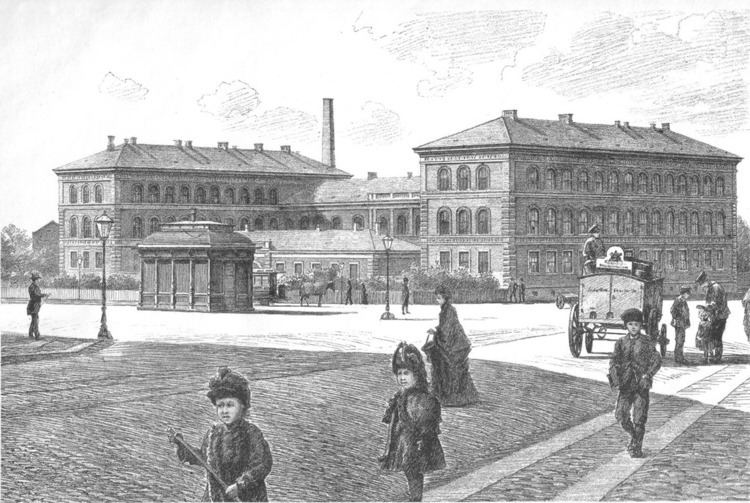Chairman Sten Scheibye Total enrollment 10,631 (2015) President Anders Bjarklev Sports Rugby union, Volleyball | Established 1829 Provost Henrik C. Wegener Phone +45 45 25 25 25 Director Claus Nielsen | |
 | ||
Former names Den Polytekniske Læreanstalt (1829–1933)Danmarks Tekniske Højskole (1933–1994) Dean Martin P. Bendsøe & Martin Vigild Undergraduate tuition and fees International tuition: 102,500 DKK (2011) Notable alumni Similar University of Copenhagen, Delhi Technological University, IT University of Copen, University of Southern Denmark, Aarhus University Profiles | ||
Developing technical university of denmark dtu
The Technical University of Denmark (Danish: Danmarks Tekniske Universitet), often simply referred to as DTU, is a university in Kongens Lyngby, just north of Copenhagen, Denmark. It was founded in 1829 at the initiative of Hans Christian Ørsted as Denmark's first polytechnic, and is today ranked among Europe's leading engineering institutions.
Contents
- Developing technical university of denmark dtu
- History
- Organization and administration
- Departments
- Research centers
- Campus
- Controversy
- Rankings
- Student organizations
- Notable alumni and faculty
- References
DTU, along with École Polytechnique Fédérale de Lausanne, Eindhoven University of Technology and Technical University of Munich, is a member of EuroTech Universities Alliance.
History
DTU was founded in 1829 as the 'College of Advanced Technology' (Danish: Den Polytekniske Læreanstalt) with the physicist Hans Christian Ørsted, then a professor at the University of Copenhagen, as one of the driving forces. The inspiration was the École Polytechnique in Paris, France which Ørsted had visited as a young scientist. The new institution was inaugurated on 5 November 1829 with Ørsted as its principal, a position he held until his death in 1851.
The new college's first home was two buildings in Studiestræde and St- Pederstræde in central Copenhagen. Although expanded several times, they remained inadequate and in 1890 a new building complex was inaugurated in Sølvgade in 1890. The new buildings were designed by the architect Johan Daniel Herholdt.
In 1903 the College of Advanced Technology commenced the education of electrical engineers in addition to the construction engineers, production engineers and mechanical engineers already educated at the college.
In the 1920s space had once again become insufficient and in 1929 the foundation stone was laid for a new school at Østervold. Completion of the building was delayed by World War II and it was not completed until 1954.
From 1933 the institution was officially known as Danmarks tekniske Højskole (DtH), which was usually translated as the 'Technical University of Denmark'. On 1 April 1994, in connection with the joining of Danmarks Ingeniørakademi (DIA) and DTH, the Danish name was changed to Danmarks Tekniske Universitet, in order to include the word 'University', thus giving rise to the initials DTU by which the university is commonly known today. The formal name, Den Polytekniske Læreanstalt, Danmarks Tekniske Universitet, still includes the original name.
In 1960 a decision was made to move the College of Advanced Technology to new and larger facilities in Lyngby north of Copenhagen. They were inaugurated on 17 May 1974.
On 23 and 24 November 1967 the University Computing Center hosted the NATO Science Committee's Study Group first meeting discussing the newly coined term 'Software Engineering'.
On 1 January 2007 the university was merged with the following Danish research centers: Forskningscenter Risø, Danmarks Fødevareforskning, Danmarks Fiskeriundersøgelser (from 1 January 2008: National Institute for Aquatic Resources; DTU Aqua), Danmarks Rumcenter, and Danmarks Transport-Forskning.
Organization and administration
The university is governed by a board consisting of 10 members: 6 members recruited outside the university form the majority of the board, 1 member is appointed by the scientific staff, 1 member is appointed by the administrative staff, and 2 members are appointed by the university students.
The President of DTU is appointed by the university board. The president in turn appoints deans, and deans appoint heads of departments.
Since DTU has no faculty senate, and since the faculty is not involved in the appointment of president, deans, or department heads, the university has no faculty governance.
Departments
Research centers
Campus
The university is located on a plain known as Lundtoftesletten in the northeastern end of the city of Lyngby. The area was previously home to the airfield Lundtofte Flyveplads.
The campus is roughly divided in half by the road Anker Engelunds Vej going in the east-west direction, and, perpendicular to that, by two lengthy, collinear roads located on either side of a parking lot. The campus is thus divided into four parts, referred to as quadrants, numbered 1 through 4 in correspondence with the conventional numbering of quadrants in the Cartesian coordinate system with north upwards.
Controversy
DTU was the subject of controversy in 2009 because the former institute director of the Department of Chemistry was a high-ranking member of Scientology. In relation to this, the university was accused of violating the principles of free speech by threatening to fire employees who voice their criticism of the institute director. On 7 April 2010, his successor was announced, at a department meeting, as Erling Stenby, who officially took over as Director on 1 May 2010.
Shortly thereafter, the university management threatened Rolf W. Berg with dismissal for publicly criticizing the university.
Rankings
In November 2007 the Times Higher Education Supplement put the university as number 130 in their ranking of the universities of the world and number 122 in 2010.
